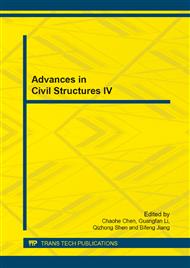p.1415
p.1419
p.1424
p.1430
p.1441
p.1449
p.1454
p.1459
p.1464
Propagating and Reconstructing Cracks in 3D in Cement-Based Materials
Abstract:
Three-dimensional reconstruction and quantitative calculation were performed by X-ray computerized tomography to propagate cracks in paste, mortar, and concrete specimens. Cracking could be observed, and the number and width of cracks increased with increasing strain and load. In mortar and concrete specimens, the number and width of cracks remained unchanged with increasing strain and load; however, a sudden increase in the number and width of cracks nearly destroyed the specimens. Cracks developed along the interface of the aggregate and the mortar in the mortar specimen. In the concrete specimen, cracks continued to grow through the coarse aggregate when cracking occurred along the stress direction. However, cracks developed along the interface of the aggregate and the coarse aggregate when cracking was independent of the stress direction.
Info:
Periodical:
Pages:
1441-1445
Citation:
Online since:
July 2014
Authors:
Price:
Сopyright:
© 2014 Trans Tech Publications Ltd. All Rights Reserved
Share:
Citation:


